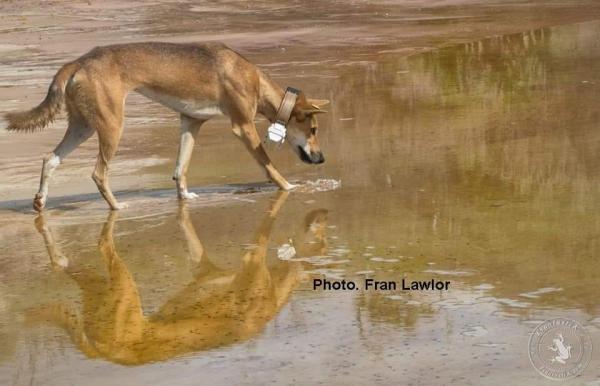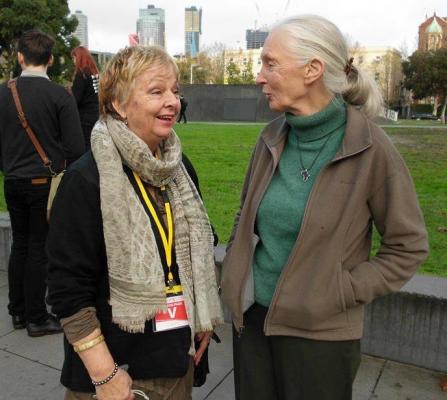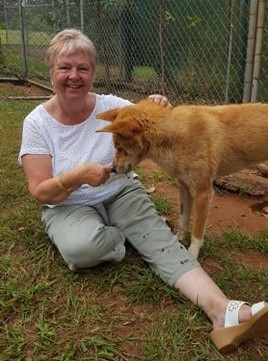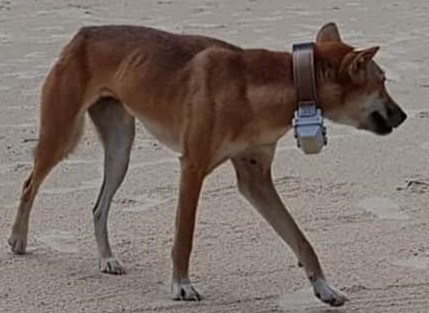A Noosa resident has received overwhelming support after starting a petition to ban the use of “cruel” collars on Fraser Island dingoes.
Peregian local Marie-Louise Sarjeant has spent years campaigning for the conservation of dingoes and her recent call to ban the “outdated” collars has received over 9000 signatures.
Marie said she first became concerned about the Fraser Island dingoes when she ran a photographic laboratory with her husband in Noosa.
“Photos started to come into the lab of emaciated dingoes on Fraser Island back in the 1990s,” she said.
“In 2011 I was horrified again at seeing the heavy collars put on the dingoes then, and seen by many concerned upset tourists.
“So, I organised a campaign run from the Eumundi markets to ask QPWS to have the collars removed.
“And now again we are seeing draconian collars on these dingoes.”
Marie said the collars in 2011 were 900 grams on an 18kg dingo and they have now pictured a female dingo with a larger collar attached.
“This collar with the questionable three boxes on would weigh much more and the dingo has had it on now since May last year 2019,” Marie said.
“It looks old and outdated stock. There are much better methods and modern equipment that can be used, such as ear tags that can send satellite data.
“This is an appalling look for Australia to use such outdated cumbersome collars on these unique iconic dingoes on a World Heritage listed Island.”
Local Badtjala elder, Ian Wheeler, was seriously concerned after there was no recent sighting of the dingo over the last week, naming her Nunyara.
There are people on the Island observing Nunyara who have said she has not been seen for several days and they have seen two more collared dingoes besides Nunyara.
Marie first began to act on her concern about the Fraser Island dingoes after meeting pioneer conservationist Dr Jane Goodall in 2014.
“I was invited to this meeting with Dr Jane in 2014, at the Melbourne Museum, for a private meeting with a few other conservationists to discuss the dingoes of Fraser Island and the persecution of dingoes over Australia,” she said.
“From that meeting at Dr Jane’s request, I organised an Australia wide event, called the National Day of Action for Dingoes (N.D.A.D), on World Environment Day 5 June 2014.
“Many other conservation groups and zoos joined in this event which made me realise that the animals and environment are all connected and I then started up the Facebook page ’Connect 2 Wildlife for Environment’ in 2014, and it has been going successfully for six years.
“The aim is bringing together wildlife campaigners with awareness and actions for wildlife.”
A Department of Environment and Science spokesperson said Queensland Parks and Wildlife Service (QPWS) uses lightweight ear tags and tracking collars (global positioning system) to monitor wongari (dingo) movements on K’gari (Fraser Island).
“Data from tracking collars is used by QPWS to better understand the species, improve management strategies and help keep dingoes, residents and visitors to K’gari safe,“ a spokesperson said.
“There are two dingoes currently wearing collars due to their displaying high-risk behaviour.
“A female has been wearing a tracking collar for 12 months, and the second animal, another female, for five weeks.
“The tracking collars have not disadvantaged or restricted the dingoes. Both animals have been observed by rangers successfully hunting and interacting with other dingoes.“
The spokesperson said the tracking collars provided valuable behavioural information.
“The female who has been wearing a collar for 12 months has provided unique, never before witnessed intelligence about her seasonal movements.
“This is a once in a lifetime opportunity to observe behavioural changes throughout the closure of K’gari in an absence of people, and her current behaviour with the return of visitors and campers.
“QPWS rangers closely monitor animals wearing a collar and will remove the collar if the animal’s condition is negatively impacted.“
Tracking collars have been used to monitor dingoes since 2011.
The spokesperson said the use of tracking collars was an established and accepted practice, and approved by an independent Animal Ethics Committee.
“The dingo’s tracking collar can be removed via a remote drop-off process when tracking is no longer required,“ they said.“Some interactions have been reported since the island reopened and DES encourages members of the public to practice dingo-safe behaviour while on K’gari.“
For more information on the petition visit chng.it/BDzvrvVyDG










